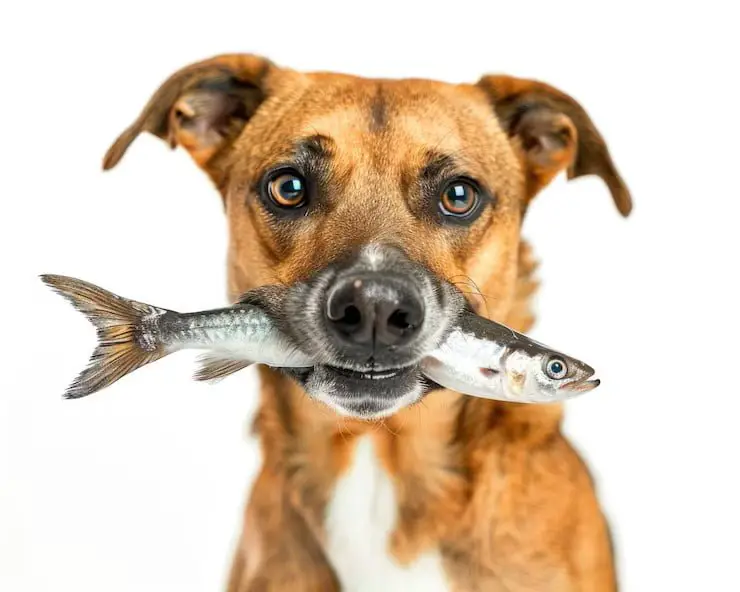Table of Contents
Can Dogs Eat Salmon
Introduction
As a responsible pet owner, you’re likely cautious about what foods to introduce into your dog’s diet. One common question is, “Can dogs eat salmon?” The answer is yes—dogs can eat salmon, but there are important guidelines to follow to ensure it’s safe. This comprehensive guide will explore the nutritional benefits of salmon for dogs, potential risks, how to safely prepare salmon, and whether dogs can eat salmon skin. By the end, you’ll have all the information you need to confidently include salmon in your dog’s diet. Source

The Nutritional Benefits of Salmon for Dogs
Salmon is not only delicious but also packed with nutrients that can greatly benefit your dog’s health:
1. Rich in Omega-3 Fatty Acids:
Salmon is an excellent source of omega-3 fatty acids, known for their anti-inflammatory properties. These fatty acids contribute to a shiny coat, healthy skin, and improved joint health, particularly beneficial for older dogs or those with arthritis.
2. High-Quality Protein:
Protein is a crucial part of your dog’s diet, supporting muscle development, tissue repair, and overall growth. Salmon provides a high-quality protein source that is easily digestible, making it suitable even for dogs with sensitive stomachs.

3. Packed with Essential Vitamins and Minerals:
Salmon is rich in vitamins such as B12 and D, which are essential for your dog’s nervous system and bone health. It also contains selenium, an important mineral that helps support a healthy immune system and thyroid function.
4. Improves Cognitive Function:
The omega-3 fatty acids in salmon have been linked to improved brain health. Including salmon in your dog’s diet may help enhance cognitive function, particularly in senior dogs.
Can Dogs Eat Salmon Fish Skin?
In addition to the flesh, many pet owners wonder, “Can dogs eat salmon fish skin?” The answer is yes, but with some caveats:
1. Nutrient-Rich Skin:
Salmon skin is rich in omega-3 fatty acids, just like the flesh. These nutrients can help maintain your dog’s coat and skin health, and the crunchy texture is often enjoyed by dogs as a treat.
2. Risks Associated with Salmon Skin:
While the skin itself is safe, it’s important to ensure it is thoroughly cooked and free of any seasonings or oils. Raw salmon skin, like raw salmon flesh, can carry harmful parasites, and oils or seasonings can upset your dog’s stomach.
3. Portion Control:
Salmon skin is higher in fat than the flesh, so it should be given in moderation, especially to dogs that are prone to weight gain or have pancreatitis.
Potential Risks of Feeding Salmon to Dogs
While salmon is beneficial, there are some potential risks to be aware of:
1. Salmon Poisoning Disease:
One of the most significant risks of feeding your dog raw or undercooked salmon is salmon poisoning disease, caused by a parasite called Neorickettsia helminthoeca. This condition can be fatal if not treated promptly. Symptoms include vomiting, diarrhea, fever, and lethargy.
2. Choking Hazards from Bones:
Salmon bones are small and brittle, posing a choking hazard or the risk of internal injury. Always ensure the salmon is boneless before offering it to your dog.
3. Mercury and Environmental Toxins:
Like many fish, salmon can contain traces of mercury and other environmental toxins. While occasional feeding is generally safe, it’s important to avoid making salmon a daily staple in your dog’s diet to minimize the risk of mercury poisoning.
4. Allergic Reactions:
Although rare, some dogs may be allergic to salmon. Symptoms of an allergic reaction can include itching, hives, swelling, and gastrointestinal issues like vomiting and diarrhea.
How to Safely Feed Salmon to Your Dog
To safely incorporate salmon into your dog’s diet, follow these guidelines:
1. Always Cook the Salmon Thoroughly:
Cooking salmon thoroughly eliminates the risk of parasites that can cause salmon poisoning disease. Steaming, baking, or grilling without added oils or seasonings is ideal.
2. Remove All Bones:
Carefully check for and remove any bones before serving salmon to your dog. Opt for boneless salmon fillets to avoid the risk of choking or internal injuries.
3. Avoid Seasonings and Additives:
Keep it simple—don’t add any seasonings, oils, or spices to the salmon. Plain, cooked salmon is the healthiest option for your dog.
4. Portion Control:
Moderation is key when feeding salmon to your dog. A small portion once or twice a week is sufficient to provide health benefits without risking any negative effects.
5. Salmon Skin:
If you decide to offer salmon skin, make sure it’s fully cooked and given in small amounts. The skin can be a healthy treat but should not replace regular meals.
Salmon-Based Dog Food and Treats
If preparing fresh salmon isn’t convenient, you can still provide your dog with the benefits of this nutritious fish through commercial salmon-based dog foods or treats. Many high-quality dog foods use salmon as the main protein source, offering a balanced diet that includes all the benefits of salmon. Additionally, salmon treats can be a tasty and nutritious snack, perfect for training or as an occasional reward.
Monitoring for Allergic Reactions or Illness
Even though salmon is generally safe, it’s crucial to observe your dog for any signs of allergic reactions or illness after introducing it into their diet:
Allergic Reactions with salmon:
Symptoms may include itching, swelling, hives, or gastrointestinal issues like vomiting and diarrhea. If you notice any of these symptoms, stop feeding salmon and consult your veterinarian.
Salmon Poisoning:
If your dog exhibits symptoms like vomiting, diarrhea, fever, or lethargy after consuming raw or undercooked salmon, seek immediate veterinary care.
Certainly! Here’s a more detailed explanation about mercury in salmon skin:
Does Salmon Skin Contain Mercury? A Detailed Examination
Salmon is widely regarded as a healthy source of protein and omega-3 fatty acids, both for humans and dogs. However, like many fish, salmon can contain trace amounts of mercury—a heavy metal that poses health risks if consumed in large quantities over time. While the flesh of the fish is commonly discussed, many pet owners and health-conscious individuals also wonder about the mercury content in salmon skin.
Understanding Mercury in Fish
Mercury is a naturally occurring element found in the environment, but it can also be released into the air through industrial processes like coal burning. When mercury enters waterways, it is converted by bacteria into methylmercury, a toxic form that accumulates in fish and shellfish. Larger, older fish, particularly those higher on the food chain, tend to have higher mercury levels because they consume smaller fish that have already accumulated mercury.
Mercury Levels in Salmon
Salmon is generally considered a low-mercury fish, especially when compared to larger predatory species such as tuna, swordfish, or king mackerel. This is because salmon are typically lower on the food chain and have shorter lifespans, which limits the amount of mercury they accumulate.
Wild-Caught vs. Farmed Salmon
- Wild-Caught Salmon: Wild-caught salmon, such as Alaskan salmon, usually have lower mercury levels because they live in cleaner environments and feed on natural diets.
- Farmed Salmon: Farmed salmon may have varying mercury levels depending on their diet and the conditions of the farm. However, studies generally show that farmed salmon also have low mercury levels, similar to or even lower than wild-caught varieties.
Mercury in Salmon Skin
Just like the flesh, the skin of salmon can contain trace amounts of mercury. Since mercury is distributed throughout the fish, the skin is not immune to contamination. However, the levels of mercury in salmon skin are generally low enough that it does not pose a significant risk when consumed in moderation.
Factors Influencing Mercury Levels in Salmon Skin
- Fish Size and Age: Larger and older salmon are more likely to have higher mercury levels because they have had more time to accumulate the metal in their bodies.
- Environmental Conditions: The mercury content in salmon can also vary depending on the waters they inhabit. Cleaner waters tend to produce fish with lower mercury levels.
- Type of Salmon: Different species of salmon may have slightly different mercury levels, with species like pink or sockeye salmon generally having lower levels than larger species like Chinook (king) salmon.
Is Salmon Skin Safe to Eat?
For both humans and dogs, salmon skin is considered safe to eat in moderation, despite the presence of trace amounts of mercury. The nutritional benefits of salmon skin—rich in omega-3 fatty acids, vitamins, and minerals—often outweigh the risks when consumed occasionally.
For Dogs:
- Moderation is Key: Given that dogs are smaller than humans and have different metabolic systems, it’s important to feed salmon skin in moderation. Offering it as an occasional treat rather than a daily food item helps minimize any potential risks from mercury.
- Cooked vs. Raw Skin: Always serve salmon skin cooked, as this reduces the risk of bacterial infections and parasites. Cooking does not eliminate mercury, but it does make the skin safer overall by removing other potential hazards.
Potential Risks of Mercury Exposure
While mercury in small amounts is unlikely to cause harm, excessive exposure over time can lead to mercury poisoning. Symptoms of mercury poisoning in dogs can include:
- Neurological Issues: Tremors, unsteady gait, and behavioral changes.
- Gastrointestinal Problems: Vomiting, diarrhea, and loss of appetite.
- Kidney Damage: Increased thirst and urination, which may indicate renal stress.
Balancing the Benefits and Risks
The key to safely enjoying the benefits of salmon skin lies in balance. The skin provides numerous health benefits, such as promoting a shiny coat and healthy skin in dogs, thanks to its high omega-3 fatty acid content. However, to mitigate any potential risk from mercury, it’s crucial to:
- Limit the Frequency: Offer salmon skin as an occasional treat rather than a regular part of your dog’s diet.
- Choose Your Salmon Wisely: Opt for wild-caught Alaskan salmon, which tends to have lower mercury levels compared to other types.
- Consider the Source: Pay attention to where the salmon is sourced from, favoring regions known for lower environmental contamination.
Conclusion
In summary, dogs can indeed eat salmon, including the skin, as long as it is properly prepared. Salmon offers numerous health benefits, from improved skin and coat health to better cognitive function, thanks to its rich omega-3 content. However, it’s crucial to cook the salmon thoroughly, remove all bones, and avoid seasonings to ensure your dog’s safety. By following these guidelines, you can safely incorporate salmon into your dog’s diet, giving them a delicious and nutritious treat that supports their overall well-being.
Salmon skin does contain mercury, but in trace amounts that are generally considered safe for both humans and dogs when consumed in moderation. The nutritional benefits of salmon skin, including its rich omega-3 content, make it a valuable addition to your dog’s diet when prepared properly. To ensure your dog enjoys these benefits without unnecessary risk, serve salmon skin cooked, boneless, and without added seasonings, and limit it to an occasional treat.
By understanding the balance between the benefits and risks, you can confidently include salmon skin in your dog’s diet, enhancing their overall health and well-being without exposing them to significant mercury risk.
FAQs
1. Can dogs eat raw salmon?
No, raw salmon is not safe for dogs due to the risk of parasites and salmon poisoning disease.
2. How often can I feed my dog salmon?
– Salmon can be fed to dogs once or twice a week in small portions as part of a balanced diet.
3. Can dogs eat salmon skin?
Yes, dogs can eat salmon skin if it is fully cooked and given in moderation. Avoid raw skin and any added seasonings.
4. What are the symptoms of salmon poisoning in dogs?
– Symptoms include vomiting, diarrhea, fever, and lethargy. Seek veterinary care immediately if you suspect salmon poisoning.
5. Is salmon better than other types of fish for dogs?
Salmon is rich in omega-3 fatty acids, making it a great choice, but other fish like sardines or mackerel can also be beneficial in moderation.
6. Can puppies eat salmon?
Yes, but in smaller portions and only if it’s thoroughly cooked and boneless.
7. Does salmon skin contain mercury?
Yes, salmon skin does contain trace amounts of mercury, just like the flesh of the fish. However, the levels are generally low and considered safe when consumed in moderation.
8. Is it safe to feed my dog salmon skin?
Yes, it is safe to feed your dog salmon skin, provided it is fully cooked and served without any seasonings or oils. Cooked salmon skin can be a nutritious treat, but it should be given in moderation to minimize any potential mercury exposure.
9. How often can I give my dog salmon skin?
Salmon skin should be given as an occasional treat, not as a regular part of your dog’s diet. Offering it once a week or less is a good rule of thumb to ensure your dog enjoys the benefits without significant risk of mercury accumulation.
10. Is there a difference in mercury levels between wild-caught and farmed salmon?
Generally, wild-caught salmon, particularly from regions like Alaska, tends to have lower mercury levels compared to farmed salmon. However, both types are usually low in mercury, making them safe options for occasional feeding.
11. What are the signs of mercury poisoning in dogs?
Symptoms of mercury poisoning in dogs can include neurological issues (such as tremors or behavioral changes), gastrointestinal problems (like vomiting and diarrhea), and kidney damage (indicated by increased thirst and urination). If you notice any of these symptoms after your dog consumes fish, seek veterinary care immediately.
12. Can puppies eat salmon skin?
Yes, puppies can eat salmon skin, but it should be given in very small amounts and always cooked. Due to their smaller size and developing systems, it’s especially important to avoid overfeeding and to monitor for any signs of an allergic reaction or digestive upset.
13. Does cooking salmon skin remove mercury?
No, cooking does not remove mercury from salmon skin. However, cooking is essential to kill parasites and bacteria that could be harmful to your dog. The key to safe consumption is moderation rather than cooking as a method to reduce mercury levels.
14. Are there safer alternatives to salmon skin for dogs concerned about mercury?
If you’re concerned about mercury, you can opt for fish skins from smaller species that generally have lower mercury levels, such as sardines or mackerel. Alternatively, you can provide fish oil supplements, which are purified and free from mercury, to give your dog the benefits of omega-3 fatty acids.
15. Can dogs eat other parts of the salmon besides the skin?
Yes, dogs can eat the flesh of the salmon as long as it is fully cooked and boneless. The flesh is rich in protein and omega-3 fatty acids, making it a healthy addition to your dog’s diet when served in moderation.
16. Is it better to feed my dog wild-caught or farmed salmon?
Wild-caught salmon, particularly from cold, clean waters like those in Alaska, is generally considered the better option due to its lower levels of contaminants, including mercury. However, both wild-caught and farmed salmon are safe when fed occasionally and prepared properly.
This FAQ section is designed to address the most common concerns and questions about feeding salmon skin to dogs, with a focus on the safety regarding mercury content. It’s meant to help pet owners make informed decisions about incorporating salmon into their dogs’ diets. Read more about Dog eating


d06ogc